Types of Black Bugs (With Pictures) – Identification Guide
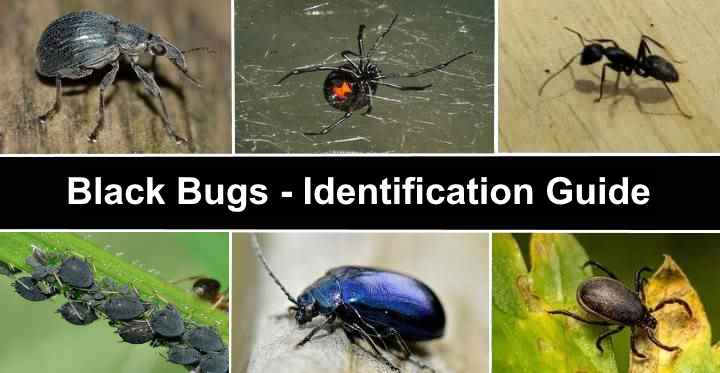
Black bugs in your home are typically nuisance pests that come in all shapes and sizes. Although most small black bugs are harmless, no one wants to see tiny black creatures crawling on work surfaces, furniture, carpets, and windowsills. Additionally, some pesky black insects can bite, causing an itchy rash while you’re sleeping in bed.
Identifying black bugs in the home is key to eradicating them. For example, some black-bodied insects are attracted to water, stored dry foodstuffs, or moist houseplant soil. Other biting black bugs lurk in dark corners and can be difficult to spot. Therefore, knowing their food sources and where they are active can help eliminate these unwanted visitors.
This article is a guide to help you identify the types of black bugs you may find in the home. You will learn about the characteristics of black insects like carpet beetles, fleas, black aphids, carpenter ants, black roaches, and more.
What are Black Bugs?
“Black bugs” refers to small pesky insects, arachnids, and mites with black bodies. Examples of small black bugs include beetles, spiders, bed bugs, fleas, fungus gnats, and black aphids. The tiny pests, like aphids or fleas, could be as small as poppy seeds or relatively large, like black cockroaches.
It’s good to note that not all small black insects are true bugs. The scientific classification of a true bug is an insect in the order Hemiptera. Therefore, scientifically, only aphids and bed bugs are bugs in the true sense of the word.
However, most people refer to bugs as any annoying insect in the home that shouldn’t be there. Therefore, this article will refer to all types of tiny black insects in the home as black bugs.
Tiny Black Bugs That Look Like Poppy Seeds
Insects like black aphids, flea beetles, and fleas are so small that the black bugs look like poppy seeds. For example, some fleas and black aphids only measure 0.04” (1 mm) and are so tiny they are difficult to notice. However, when several are together, their appearance may resemble tiny scattered black seeds.
Types of Black Bugs (With Pictures)
One of the most common types of black bugs you might find in your home is carpet beetles. However, many other kinds of adult beetles, bed bugs, aphids, fleas, ants, spiders, and centipedes also have black bodies. They can infest kitchens, bathrooms, and living rooms.
Let’s look in detail at identifying characteristics of several types of black bugs in the home.
Black Carpet Beetle (Attagenus unicolor)
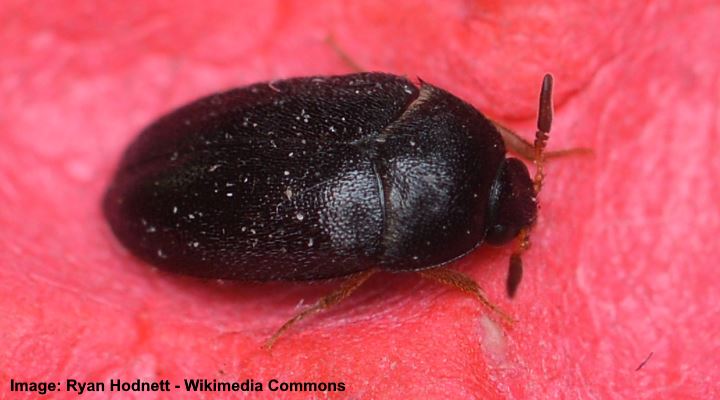
The black carpet beetle is a tiny bug that infests carpets and fabrics in the house
The black carpet beetle is one of the most common black pests in the home. A black carpet beetle has a black oval body, a hard shell covering four wings, six legs, and two stumpy antennae. These small dark brown to black beetles are oval and measure 0.125” to 0.19” (3 – 5 mm) long.
The adult black carpet beetles fly or crawl indoors and can infest furniture, and soft furnishings.
Carpet beetles are most destructive in the larval stage of their life cycle. The long, brown, hairy, cylindrical grubs feed voraciously on wool, clothing, carpets, natural fibers, and other fabrics, leaving behind irregular holes. The larvae also feed on pet food and protein-rich items in pantries.
Signs of carpet beetle activity in a home include holes in fabrics, cast-off larva carcasses, and a musty odorous smell. The brown larval bugs can be a nuisance because they can live for up to two years before pupating into adult beetles.
Carpet beetles can also become serious pantry pests. The bugs can live in containers of flour, stored grain, cereals, nuts, rice, and flour.
Related reading: How to get rid of kitchen bugs.
Black Bug Identification: The identification features of the black carpet beetle are a small shiny black body, small clubbed antennae, six legs, and an oval shape.
Black Aphids (Aphis fabae)

A close up picture of black aphids and tiny aphid nymphs
Black aphids are flying black bugs that attack houseplants and ornamental shrubs in gardens. These small flying, soft-bodied bugs measure around 0.78” (2 mm) in length and closely resemble black poppy seeds. However, upon closer inspection, you can notice faint white spots on their backs. These pesky insects feed on plant juice, which can weaken the host plants over time.
Black aphids are more noticeable as they congregate in groups on the underside of leaves. Because they belong to the bug order Hemiptera, they have piercing mouthpieces that bite plant tissue so they can extract the juices.
Signs of these black bugs on plants are sticky honeydew, black sooty mold, and clusters of black dot-like bugs under leaves.
Related reading: How to kill aphids on indoor plants.
Black Bug Identification: Also called blackflies, black aphids are identified by their tiny bulbous abdomen, long antennae, and black-tipped pale yellow legs.
Black Flea Beetles (Alticini)
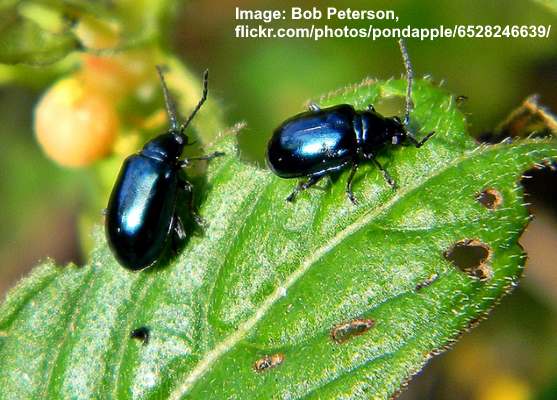
Metallic blue-black flea beetles (Altica chalybea) chew on a leaf
The black flea beetle is a small black insect that looks like a poppy seed and is commonly found in gardens and homes. The tiny black beetle has a glossy, oval body measuring 0.06” to 0.12” (1.5 – 3 mm) long. You will likely find the leaf beetles chewing on garden plants, leaving behind small holes in foliage.
Flea beetles are jumping bugs that destroy plant leaves. The bug damage looks like fine buckshot on leaves. In some cases, a severe black flea beetle infestation can defoliate an entire plant.
Flea beetles get their name from their jumping habit—like fleas. Although many species are primarily black, flea beetles can be striped, metallic, or black beetles with a red head.
Black Bug Identification: Identifying features of the black flea beetle are its shiny black oval body and large hind legs it uses for jumping.
Fleas (Siphonaptera)
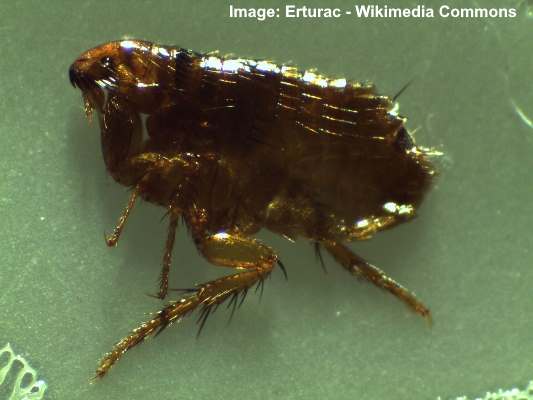
A close up picture of a flea (35x zoom optical microscope)
Fleas are tiny jumping bugs that use their mouthparts to pierce human and animal skin to suck blood. These minuscule bloodsucking insects measure 0.039” to 0.13” (1 – 3 mm). The adult flea has a flattened body, long legs they use for jumping, fine hairs, and short spines.
Fleas can become severe pests in homes where the tiny dark brown to black bugs hitch a ride on family pets or clothing. The tiny black bugs can lay eggs in soft furnishings where tiny worm-like larvae hatch.
Signs of flea infestations include red welts on the skin from flea bites, severe itching, and black pepper-like marks (frass or feces). The best way to get rid of fleas is to treat pets for fleas and thoroughly vacuum carpets, upholstery, and the nooks and crannies of furniture.
Black Bug Identification: Fleas look like tiny black dots and are hard to identify. They jump so high and rapidly that they seem to disappear as soon as you try to catch one.
Black-Legged Tick (Ixodes scapularis)

Black-legged male tick (left) is completely black, whereas the female (right) has black and brown colors
Also called the deer tick, the black-legged tick is a bloodsucking bug with a black body (male) or black and brown body (female). The tiny black bugs measure less than 0.13” (3 mm). The brown or black tick resembles an apple seed with tiny black legs. The ticks grow in size when they become engorged during a blood meal.
Black-legged ticks can be dangerous bugs because they transmit diseases. Active from early spring to late fall, the nasty bugs burrow into the skin to feed on blood. In this way, they can transmit Lyme disease or other bacterial tick-borne infections.
Black Bug Identification: The black-legged tick is identified by its tiny black oval body, reddish-brown markings (females), and black legs.
Black Weevils
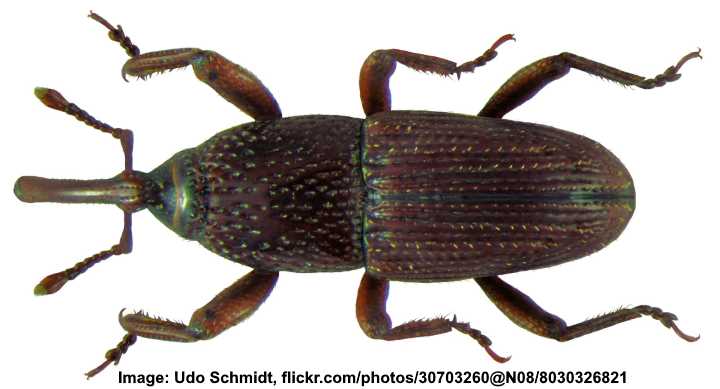
Granary weevil (Sitophilus granarius) is a type of flour weevil and is identified by a dark brown-blackish body with ridges and long snout
Many types of black weevils in the home are pantry bugs that live in rice, flour, and other stored cereals. Weevils are easily identified due to their characteristic long snout, pear-shaped body, two short antennae, and six legs. Most pantry weevils measure 0.12” to 0.20” (3 – 5 mm) long.
Types of pantry weevils with dark brown or black bodies include the following species of beetles:
- Rice weevils
- Granary weevils
- Maize weevils
- Bean weevils
Signs of a weevil infestation include silky webs inside food packaging, black dots in food (dead carcasses), or a black powder-like substance from their poop.
Black Bug Identification: Identification features of black weevils include their oval bodies, small heads, and long, slender snouts.
Fungus Gnats
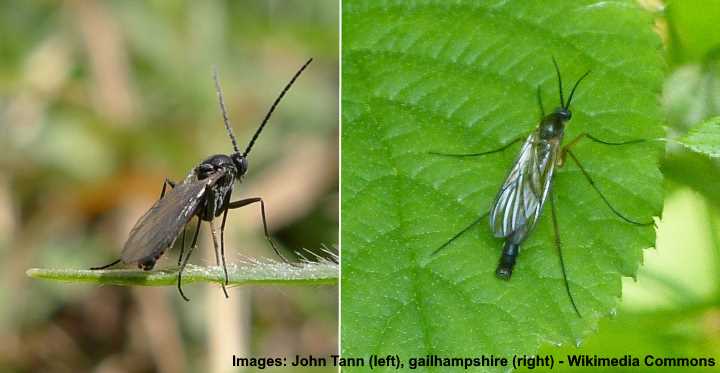
Fungus gnats (soil gnats) are soil dwelling small black houseplant pests that feed on fungus
Fungus gnats are black bugs on houseplants with six legs, translucent wings, and a pair of antennae. The tiny flying insects love to live in damp potting soil and tend to swarm around potted plants. The tiny slender black fungus gnats grow 0.06” to 0.13 (1.5 – 3 mm) long. The female gnats lay eggs in potting soil, where the larvae hatch and feed on rotting roots.
Despite being common houseplant pests, black fungus gnats don’t bite, or transmit disease. The flying black insects are more of a nuisance when they fly in your face. The small black insects are easy to confuse for fruit flies or drain flies.
Related reading: How to get rid of fungus gnats.
Black Bug Identification: Fungus gnats look like tiny flies that hover over houseplants or moist potting soil.
Black Carpenter Ants (Camponotus)
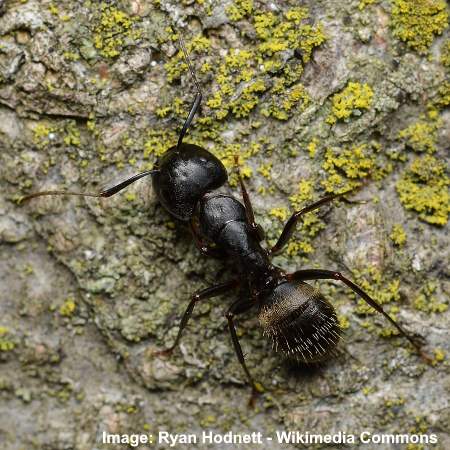
The big black carpenter ant (Camponotus pennsylvanicus) can damage wooden furniture and structures
The black carpenter ant is a slender black bug with a bulbous abdomen, thin waist, and long legs. Depending on the species, these large ants measure 1.57” to 0.51” (4 – 13 mm) long. The black ants are typically easy to spot because they scurry about floors, windowsills, and porches in large groups.
Black carpenter ants can inflict a painful bite. The black bugs get into homes through windows, cracks in walls, or where plumbing enters homes. Apart from biting, the ants cause damage by tunneling into wooden structures like decks, porches, window frames, and roof eaves.
Black Bug Identification: Carpenter ants are identified by their large, rounded black bodies, long legs, elbowed antennae, and a single segmented node connecting the thorax and abdomen.
Black Garden Ant (Lasius niger)
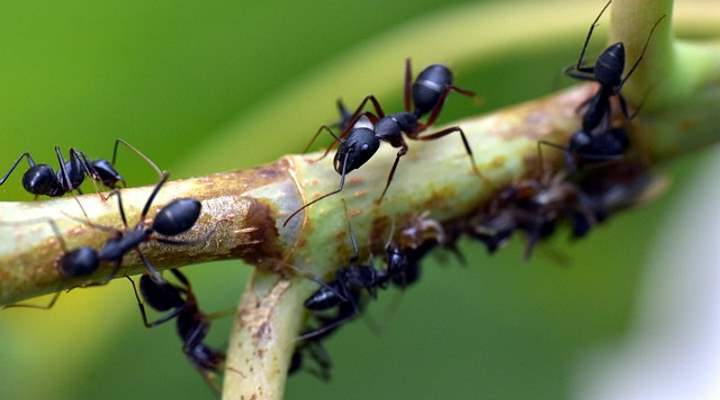
The small black garden ant is common in many parts of the world
Also called the common black ant, this species of garden ant can easily find its way into homes. The glossy black ants measure 0.12” to 0.20” (3 – 5 mm) long. Like all ants, this species has a three-segmented body, large elbowed antennae, and six legs.
Black garden ants get into homes, attracted by sweet foods and moisture. Although they tend to leave humans alone, the black bugs can become a nuisance because they contaminate food with their feces and build nests in basements. In addition, the ants have a swarming habit which can make them a pest indoors or in gardens.
Black Bug Identification: Identification features of common black ants are their slender bodies with bulbous heads and abdomens and relatively small size.
Pillbugs (Armadillidiidae)
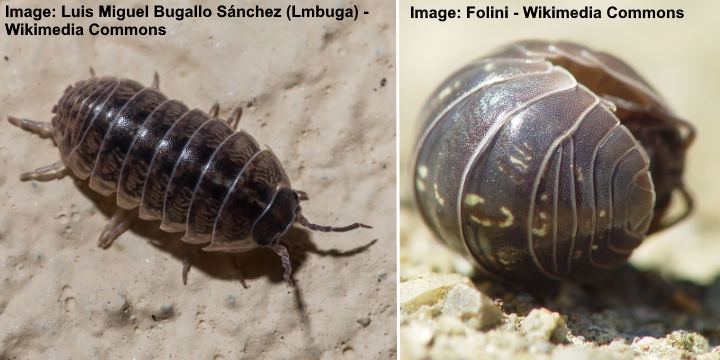
Pillbugs have dark hard segmented shell and can roll when they feel threatened
Pillbug is an isopod (not an insect or bug) with a grayish-black segmented body resembling armored plates. The “bugs” are a type of woodlice that grow 0.33” to 0.70” (8.5 – 18 mm) long. The unusual creature has seven pairs of legs and seven main body segments, giving it the look of a tiny armadillo.
Despite the name pillbugs, the unusual insects are not bugs in the true sense of the word. Instead, they are a type of crustacean in the family Armadillidiidae.
Pillbugs are nocturnal and typically found in yards under stones, logs, and garden debris. They can occasionally become pests in the home if they wander indoors; however, that is very rare.
Black Bug Identification: Pillbugs are unusually dark gray or black-colored “bugs” with armor-like bodies. They also have the habit of rolling into a ball when threatened.
Oriental Cockroach or Waterbug (Blatta orientalis)
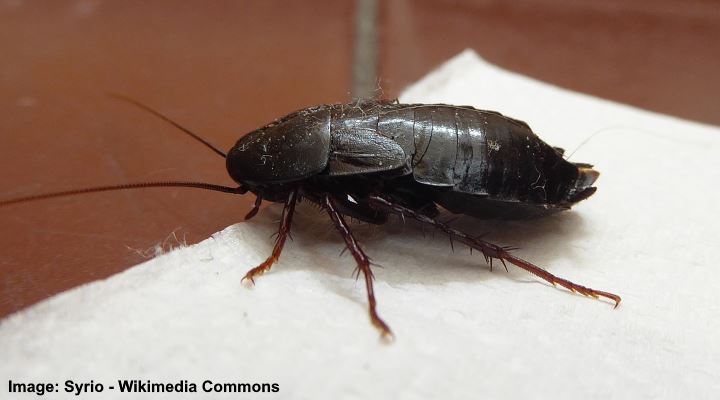
Waterbug are black bugs with hard shell and two long antennae
Also called the black cockroach, the oriental cockroach is a dark-colored pesky winged insect that can become a significant pest indoors. The relatively small insects measure 0.79” to 1.06” (20 – 27 mm) long. The black bugs have an oval, flattened body, six spiny legs, and two large antennae.
Male oriental roaches have tinges of bronze on their bodies and wings that cover about 3/4 the length of their bodies, while females have much shorter wings. Despite its wings, the pesky oriental cockroach cannot fly.
The disease-carrying pests thrive in high humidity and temperatures between 68°F and 84°F (20°C – 29°C). These nocturnal pests typically reside in crawl spaces, under sinks, and sewer pipes. They carry disease because they feed on garbage and decaying organic matter.
Compared to the brown native American cockroach, the black Oriental roach is about half the size.
Black Bug Identification: The Oriental cockroach is identified by its leathery dark brown to black body, oval shape, and wings. However, these pesky black bugs cannot fly.
Black Widow Spider (Latrodectus)
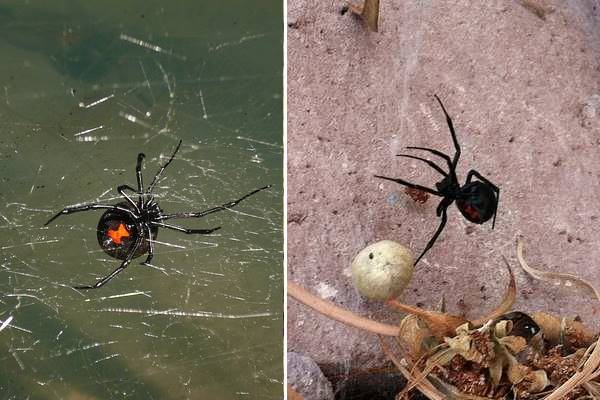
Black widow spider (Latrodectus mactans): underside view (left) showing the reddish hourglass marking and top view (right)
The black widow spider is one of the most dangerous black bugs in the home. The easily identifiable black spider has the characteristic red hourglass marking on its bulbous black abdomen. The small black spiders grow 0.1” to 0.4” (0.3 – 1 cm) long.
The danger of black widow spiders is their painful, poisonous bite. Usually, the initial bite is like a pinprick. However, the neurotoxins in the black and red spider bite cause painful swelling and may result in muscle spasms, cramps, and aching joints.
Black widows typically lurk in dark crevices, footwear, pockets, and behind baseboards and will attack when provoked. One sign of black widow spider activity in the home is their messy webs near ground level or large silken egg sacs in doorways.
Black Bug Identification: The identification feature of the black widow spider is its brightly colored red marking on the underside of its abdomen.
American Spider Beetle (Mezium americanum)
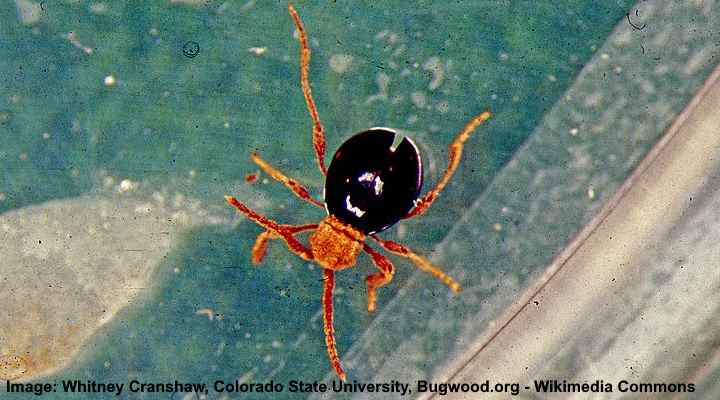
American spider beetle has black body with fuzzy orange legs, head and antennae
The American spider beetle is a common black and orange house beetle that typically only comes out at night. The unusual beetle has a large, rounded glossy black body with an orange to red head, legs, and antennae. The small beetles measure 0.06” to 0.14” (1.5 – 3.5 mm) long.
Spider beetles typically reside in dark, damp locations. As a result, they can infest pantry cupboards, attics, or wall cavities.
Black Bug Identification: Easily identifiable spider beetles have a black bulbous abdomen and orange legs, head, and antennae. Some species of this spider beetle are chocolate brown with pale yellow legs.
Centipedes

Centipedes are long creepy house bugs that are identified by numerous pairs of legs
Many species of centipedes look like fat black worms with numerous pairs of legs. Black centipedes can become a pest in the home when attracted to moisture. Apart from the black creepy crawly looking gross, the bugs can inflict a painful bite if you handle them.
Depending on the species, the worm-like crawling arthropods can be tiny black bugs—less than an inch. Or they can be huge creatures measuring around 12” (30 cm) long. However, house centipedes tend to average 4” (100 mm) long.
Black Bug Identification: Centipedes are easy to spot because of the many pairs of legs along their slender, long bodies. Some species may have a hairy appearance, whereas others are long and smooth.
Insidious Flower Bug (Orius insidiosus)
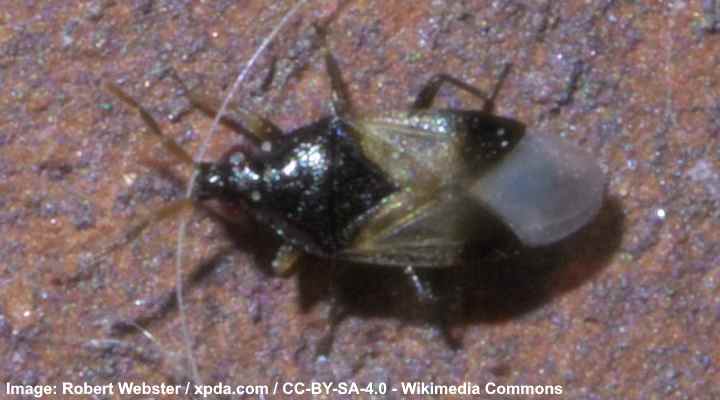
The black insidious flower bug has white tail and is a beneficial garden bug
The insidious flower bug is a black and white bug with beneficial uses as a predatory garden insect. The tiny black bugs measure 0.13” (3.3 mm) and have a distinctive white marking at their tail end, and white patches on their wings. The small bugs prey on aphids, thrips, whiteflies, spider mites, and other plant bugs.
Black Bug Identification: The insidious flower bug has a black oval body with black and white patches on its wings.
Related articles:
